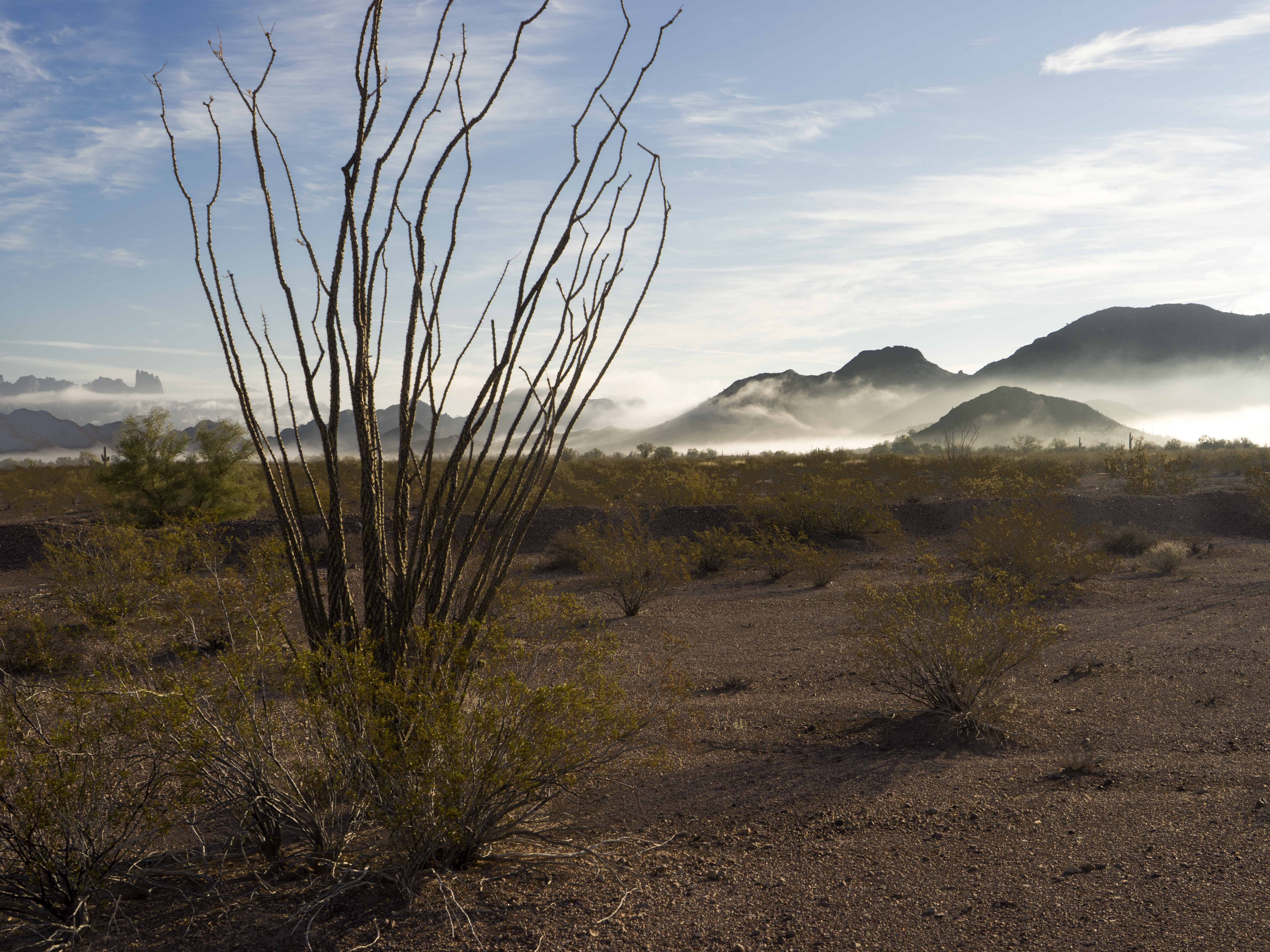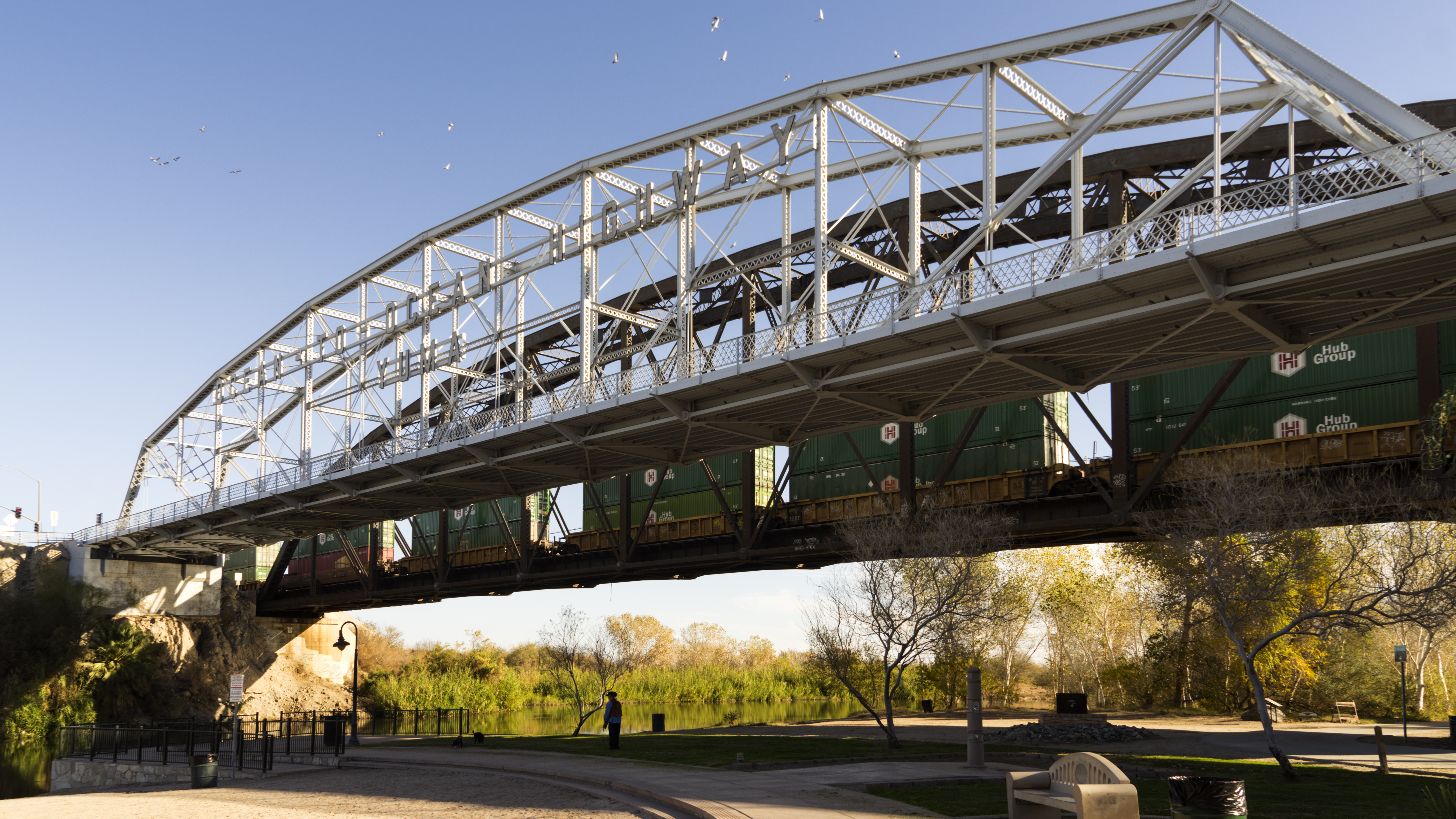The Queen and I took time out of our busy schedule to make our quarterly dentist visit this week. Usually, you’d think that would take maybe an hour or two. For us, it’s more of a commitment than that. As seniors, our dental insurance is nil to none, so upon the recommendation of a couple of friends, we found a good dentist in Algodones, Mexico—which means an overnight journey to Yuma. We got an add-a-tooth-to-me, so the first appointment was for a root canal and an impression to send to the lab overnight. The next day, the crown was fitted.
It’s been an abnormally wet year for us here in the desert, so when we left Monday at daybreak under a cloudless blue sky, we felt like we were wasting a good work day. The rains kept us cooped up all weekend while we had outside projects we’d put off for dry weather. Instead, we were on the road for three hours for an 11:00 am appointment.
As the sun rose, we saw fog patches, something we rarely get. The evening breeze pushed the ground fog to the base of the low ranges like door-stops. The dark hills popped out of the strands of white. South of Quartzsite, I couldn’t take it anymore and pulled off the road to snap a shot as we passed through the KOFA (King of Arizona) Wildlife Refuge. Even so, we made it with time for breakfast before our appointments.

Los Algodones is a retirees’ equivalent of Disneyland. The downtown commerce area is an eight-block square along the east bank of the Colorado River. It’s a tiny border town compared to Juarez, Nogales, Tijuana, or even Mexicali; it’s sixty miles to the west, yet it’s still a Class A border crossing. That’s because of the large amount of foot traffic. There is some vehicular traffic crossing there, but most people pay six dollars to the Quechan tribe to park in their vast parking lot and walk across.
The dominant feature is a multi-story steel beam structure like an unfinished building. It’s been unfinished since we first visited some twenty-five years ago and will likely not be different in the next twenty-five years. Then there are the hustlers. Unlike Tijuana, they’re not trying to get you into one of the girly clubs (of which there are none); they’re working for dentists, eye doctors, pharmacies, or liquor stores. That’s right; the doctors got pimps. After you wander the town a bit, you realize the city is a medical amusement park. Within a block, you can get glasses, a tooth implant, new hearing aids, and a sombrero, and you can have a margarita for lunch while you’re waiting for the lab.
As a younger man, I never would have gone to a doctor in Mexico. I had heard the horror stories of shoddy work and surgery disasters, so why the change of heart now? It’s a combination of economics, referral, and desperation. We need dental work but couldn’t pay what the local dentists were charging . . . even with insurance. So, if I had a problem with a tooth, out it came. After retiring and hanging out with other like-minded geezers, we heard some good stories and got some strong referrals.
On our summer trip, I broke two crowns, so when we got back, we scheduled an appointment to investigate. Sitting in the tiny waiting room, people our age surrounded us, claiming our dentist was the best. The first exam was simple, consisting of digital X-rays, little cameras, and some poking and prodding. Within fifteen minutes, they printed out a chart of my mouth showing the work I needed, including the cost by tooth. Then, they went over the X-rays and photos so I could see what they were talking about. After that, they cleaned my teeth, and then I was done . . . $25.00. When we left the office, we both had our charts, and it was our decision about which teeth to work on and when. All of the prices were less than what our co-pay would be in the States.
As always, the devil must have his due. What you save in money, you pay with time. I have already pointed out that the waiting room is crowded with loyal patients. It is to a fault. Your 11:00 am appointment only means you’ll be seen sometime after that. If you need to see a specialist, they call an escort to take you there, where you can sit in another waiting room that always has one less chair than people. If you’re lucky, the TV has a Discovery Channel in Spanish. Otherwise, it will be CNN. If your visit requires replacement parts, the lab will always have them ready tomorrow. Give it up if you count on returning to the road at a decent hour. You will only have enough time to grab a Big Mac at the Yuma Mickey D’s before the three-hour drive home in the dark.
Western Arizona is one of the weirdest places on earth. It’s all low-lying Sonoran Desert dominated by creosote bushes, Palo Verde trees, and an odd saguaro here and there. It also gently slopes downhill towards Yuma, the lowest place in the state. It’s also the warmest and driest part of the state, both winter and summer. No one lives there.

While driving to Yuma in September, we counted twenty-five empty RV parks along the road. Quartzsite, the halfway point of the trip, was a ghost town with most stores closed. On Monday’s trip, they were packed with people from Montana, Alberta, Idaho, Saskatchewan, Washington, and British Columbia. They all come down to the warm desert and camp under the stars. Except for an occasional Costco run, they never go into Phoenix, and the Phoenicians aren’t aware that these people are out there. After all, who goes to Quartzsite? The campers also go to Algodones for doctors, prescriptions, and booze.
On the Immigration Service Website, it says that the Algodones Customs Station averages over two thousand pedestrians a day. I’ve been there on days when you could walk right into the customs house and be on your way two minutes later. Over four thousand people were waiting in line this week to cross the border. The line curled back from the custom house and several blocks down the street. For over an hour, we marched a step or two at a time while chatting with our neighbors and carrying one bag of prescriptions and another containing one bottle of Kahlua or tequila.
Towards day’s end, the street vendors grab an armload of goods, abandon their stalls, and make their way to the line waiting at customs. They form a gauntlet imploring you to buy a poncho, sombrero, or a giant carved wooden turtle. On your other side, older women dressed in black hold a swaddled infant and offer Chiclets for spare change. They move on if you smile and softly say, “No. Thank you.” If you dare feel the lace or try on a hat, you’re dead meat until you agree on a price. Being a Baby Boomer, I can tell you that they’d make a fortune selling street tacos and Margaritas to-go along that exit line.
Till then . . .
jw
